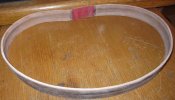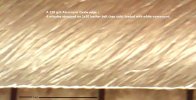- Joined
- Feb 25, 2011
- Messages
- 275
Would you be willing to send me a little bit of your bulk compound?
The BladeForums.com 2024 Traditional Knife is available! Price is $250 ea (shipped within CONUS).
Order here: https://www.bladeforums.com/help/2024-traditional/
gmail me.Would you be willing to send me a little bit of your bulk compound?
Chris "Anagarika";12044550 said:Edit to add: as urban dweller, my use is light, paper shredding (3-4mm strips to be, from A4 paper), tea packages (aluminium foil) and shaving. Sometimes, pizza cutting (on the box-cardboard) and then testing shredding the cardboard plate it's on.
gmail me.
Gmail sent!
...
When you are testing out all of these different stropping compounds, are you doing each one on a fresh horse-butt strop, or are you scraping one compound off and then applying a different one?
I hope my testing of the "balanced strop" will be useful to you. I have never used a strop before, so if I can improve the edges I am producing on the Edge Pro, then I think you can safely conclude that anyone can benefit from this "idiot-proof" strop concept. I consider myself just one-half step above an idiot when it comes to sharpening.
Gotta be stingy with 30cents/foot of leather


Yes and I used 220 because the Aluminum Oxide stone happenned to be next the 1x30 belt grinder. For rough works, grit between 220 and 600 + strop would give best edge retention.Chris "Anagarika";12123053 said:Do I get this correctly? 220 grit + strop resulting in better edge retention?
Chris "Anagarika";12125450 said:Got it.
On another thread, it's mentioned that strop has to use the smooth side. However on this balance strop, you recommend using rough side, which gave me good result. Any 'hand waving' theory on this?
This is why, to this day, I've never ruled out either (smooth or rough). So many variables play into it: leather character, compound, backing or substrate (wood/cardboard/paper/glass/hanging strop), steel type, edge grind (V-bevel/convex), desired edge finish (coarse/polished), individual technique, pressure, speed of stroke, etc., etc., etc.. I've noticed that some of my knives seem to 'like' one way, and other of my knives respond well to the other. And even then, I often see changes in outcome with further experimentation and evolution in my own skill/technique. In a nutshell, I try to keep an open mind, and it seems to always teach me something new.
David
Chris "Anagarika";12125450 said:On another thread, it's mentioned that strop has to use the smooth side. However on this balance strop, you recommend using rough side, which gave me good result. Any 'hand waving' theory on this?
Try strop some more, it should refine the edge - hence making it less toothy. Instead of sharp teeth, now it would be more like shallow scallop micron-serration. I do this with many of my knives, once the edge is too smooth, I would back hone to certain toothy grit (mostly 400 or 600 or 1K or 4K) then strop.Chris "Anagarika";12197964 said:Update: it retains the slicing agressiveness better, but not comfortable for shaving. I have to repolish this I guess, or strop it more ...
I've tested a strop surface made from small manila/jute ropes. After 2 weeks of test, I found this surface is more versatile and much lower maintenance than leather. Although, freshly charged compound on nap-leather produced a slightly more reflective/mirror finish. A well-used manila strop easily matched leather finishes.
+ A manila rope strop
+ Image capture setup
+ A Mora with new 26* bevel reprofiled and finished on on a brand new manila strop loaded with bulk white-compound (12-15um AlO)
View attachment 340220
View attachment 340219
View attachment 340216View attachment 340217View attachment 340218
It gave a clean dry shaved (low angle and not much pressure) of facial stubbles, also removed some skin in the form of dust. Sharp and too coarse
edit: should mention that this manila rope strop works quite well for stropping serrated knives.
